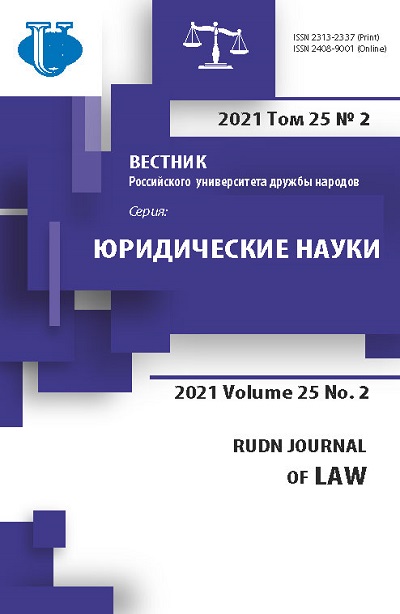Critical evaluation of English and Saudi insurance law: A case for reform
- Authors: Albalawi K.M.1
-
Affiliations:
- Tabuk University
- Issue: Vol 25, No 2 (2021)
- Pages: 582-600
- Section: CIVIL LAW
- URL: https://journals.rudn.ru/law/article/view/26715
- DOI: https://doi.org/10.22363/2313-2337-2021-25-2-582-600
- ID: 26715
Cite item
Full Text
Abstract
The global significance of English law continues, particularly in Saudi as it is the most frequently chosen insurance policy law. Both jurisdictions provide consumer protections in insurance markets including the Consumer Insurance (Disclosure and…) Act and the 2015 Insurance Act and the Insurance Consumer Protection Principles 2014 in Saudi Arabia. This study aims to analyse the current reform impact on the interpretation of these doctrines between the UK and Saudi jurisdictions. In the last few years British insurance law has been significantly reviewed and modified and the most recent amendments, as per the Insurance Act 2015, are of the greatest significance and will be given due consideration within this paper. However, both the rationale for the reforms and the reform process will be reviewed as well as the UK perspective of the increasing rivalries between countries on account of legal business.
Keywords
About the authors
Khalaf M. Albalawi
Tabuk University
Author for correspondence.
Email: km.albalawi@ut.edu.sa
Doctor, Assistant Professor of Commercial Law and Insurance Law, Law School
University City, Staff Campus, Tabuk 47512, Saudi ArabiaReferences
- Abu Orabi, G. (2011) Insurance Contracts: a Comparative Study. Dār Waa’il. (in Arabic).
- Aljallal, A.I.A. (2014) The duty of good faith in insurance law: a study of Saudi law compared to English law. Т. 2. University of Southampton, School of Law, Doctoral Thesis.
- Birds, J. (2016) Birds’ Modern Insurance Law. Sweet & Maxwell.
- Hasson, R.A. (1969) The Doctrine of Uberrima Fides in Insurance Law: a critical evaluation. The Modern Law Review. 32 (6), 615-637.
- Hodges, S. (1999) Cases and Materials on Marine Insurance Law. London, Cavendish Publishing Ltd.
- Lowry, J. (2009) Whither the Duty of Good Faith in UK Insurance Contracts Whither the Duty of Good Faith in UK Insurance Contracts?" Connecticut Insurance Law Journal. 16 (1), 97-156.
- Lowry, J., Rawlings, P. & Merkin, R. (2011) Insurance Law: Doctrines and Principles. Edition 3rd. Hart Publ.
- Lowry, J. & Rowling, P. (2012) That Wicked Rule, that Evil Doctrine: Reforming the Law on Disclosure in Insurance Contracts. Modern Law Review. 75(6), 1099-1122.
- Mahat, M.A.A. (2015) The Doctrine of Khiyar al-’Ayb as proposed by Muslim Jurists and its Maqāsid in Islamic Transactions. In: International Conference on Maqasid al-Shari’ah in Public Policy and Governance. Malaysia, International Institute of Advanced Islamic Studies (IAIS).
- McGee, A. (2014) The Reform of English Insurance Law: Attracting Business in the 21st Century. The Asian Business Lawyer. (16), 73-85.
- Merkin, R. & Lowry, J. (2008) Reconstructing Insurance Law: The Law Commissions’ Consultation Paper. Modern Law Review. 71 (1), 95-113.
- Merkin, R. (2016) What Does an Assured ‘Know’ for the Purpose of Pre-Contractual Disclosure? 27 Insurance Law Journal.
- Merkin, R.M. (2010) Colinvaux’s Law of Insurance. London, Sweet and Maxwell.
- Merkin, R. & Gürses, O. (2015) The Insurance Act 2015: Rebalancing the Interests of Insurer and Assured. Modern Law Review, 78 (6), 1004-1027.
- Merkin, R. & Gürses, O. (2016) Insurance Contracts after the Insurance Act 2015. Law Quarterly Review. 132 (3), 445-469.
- Noussia, K (2019) Transparency in the Insurance Contract Law of England. In: Pierpaolo Marano & Kyriaki Noussia (eds.) Transparency in Insurance Contract Law. Cham, Switzerland, Springer. pp. 573-590.
- Thanasegaran, H. (2016) Good Faith in Insurance and Takaful Contracts in Malaysia: A Comparative Perspective. Singapore, Springer Science and Business Media.
- Tyldesley, P. (2013) Reform at Last. In: Tyledysley P. (ed.) Consumer Insurance Law: Disclosure, Representation, and the Basis of Contract Clauses. Bloomsbury.
- Shukrī, B. (2011) At-Ta’meen fi’t-Tatbeeq al-Qadā’ wa’l-Qānūn. Dār uth-Thaqāfah. (in Arabic).
- ’Uthaymeen, M. (2002) Ash-Sharh Al-Mumti' Ala Zad Al-Mustaqni'. T. 11. Dār Ibn ul-Jawzī. (in Arabic).
- Wang, F. (2017) Illegality in Marine Insurance Law. Abingdon, Oxon, Routledge.
Supplementary files















